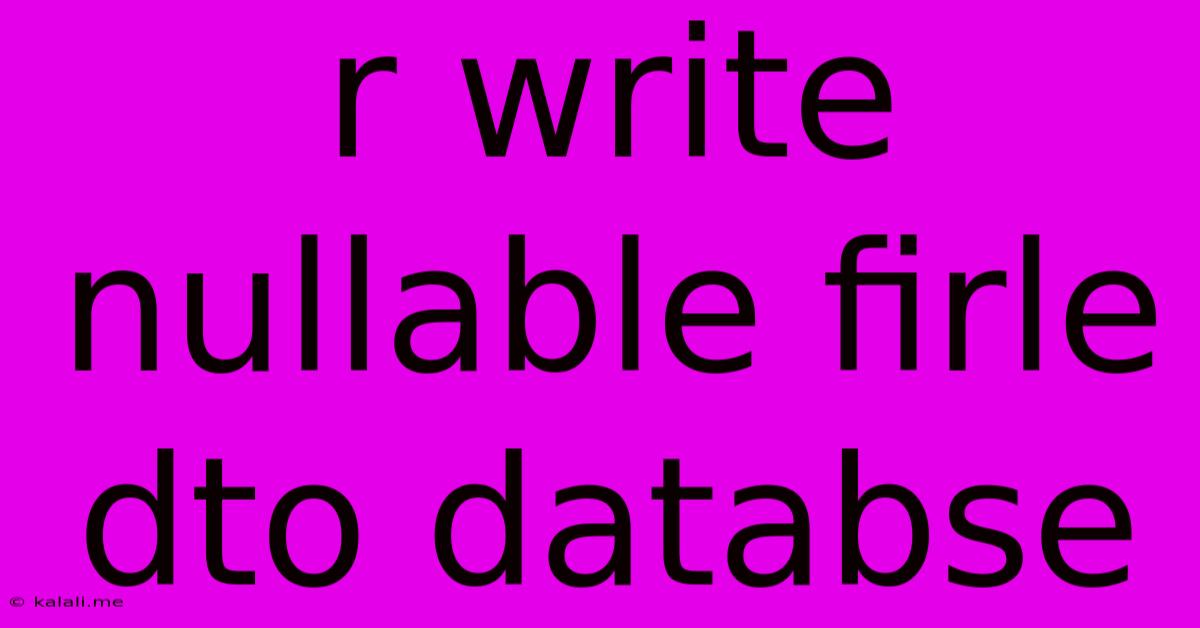R Write Nullable Firle Dto Databse
Kalali
Jun 09, 2025 · 3 min read

Table of Contents
Handling Nullable Fields in DTOs and Database Interactions
This article explores best practices for managing nullable fields when working with Data Transfer Objects (DTOs) and database interactions. We'll cover strategies for representing null values, handling them during data transfer, and ensuring data integrity in your database. Understanding these techniques is crucial for building robust and efficient applications.
What are DTOs and Why are Nullable Fields Important?
Data Transfer Objects (DTOs) are simple objects used to transfer data between different layers of an application, such as between the database and the presentation layer. They often mirror the structure of database tables, but with added functionalities like validation rules or data transformations.
Nullable fields represent attributes that may or may not have a value. Handling these correctly is essential to prevent errors and maintain data consistency. Incorrect handling can lead to database integrity issues, unexpected application behavior, and difficult-to-debug problems.
Representing Nullable Fields in DTOs
Most programming languages offer ways to represent nullable fields. Common approaches include:
-
Optional Types: Languages like Kotlin and Swift provide optional types (e.g.,
String?in Kotlin) that explicitly indicate a field can be null. This improves code clarity and helps prevent null pointer exceptions. -
Wrapper Classes: In languages like Java, you can use wrapper classes (e.g.,
Integerinstead ofint) to represent nullable primitive types. Anullvalue in a wrapper object clearly signifies the absence of a value. -
Boolean Flags: In simpler scenarios, you might use a separate boolean flag to indicate whether a field has a valid value. This approach is less elegant but can be suitable for specific situations.
Mapping DTOs to Database Tables
The mapping between DTOs and database tables is crucial for handling nullable fields effectively.
-
Database NULL Values: Databases typically use
NULLto represent missing or unknown values. Your ORM (Object-Relational Mapper) should automatically handle the mapping betweenNULLin the database and the equivalent representation in your DTO (optional type, wrapper class, etc.). -
Database Constraints: Consider adding
NOT NULLconstraints in your database schema if a field must always have a value. This enforces data integrity at the database level, preventing accidental insertion or update of null values. -
Default Values: If a field allows null values but you have a reasonable default, set it accordingly in your database schema. This can simplify your application logic and provide a consistent value when a field is not explicitly set.
Handling Nullable Fields During Data Transfer
-
Validation: Implement input validation to ensure data integrity. Check for null values where required and handle them appropriately (e.g., throw an exception, use a default value, or provide feedback to the user).
-
Conditional Logic: Use conditional statements (e.g.,
ifstatements) to check for null values before performing operations that could throwNullPointerExceptions. -
Null-safe Operators: Utilize null-safe operators (like the Elvis operator
?:in Kotlin) to provide default values or alternative actions when a field is null.
Best Practices
-
Be Explicit: Clearly indicate nullable fields in your DTOs using the appropriate language features.
-
Handle Nulls Gracefully: Anticipate null values and handle them properly to prevent runtime errors.
-
Database Constraints: Use database constraints to enforce data integrity.
-
Consistent Approach: Maintain a consistent approach to handling nullable fields throughout your application.
-
Documentation: Document your handling of nullable fields to aid maintainability and collaboration.
By following these guidelines, you can efficiently manage nullable fields in your DTOs and database interactions, building more reliable and maintainable applications. Remember, clear code, robust error handling, and a well-defined database schema are key to success.
Latest Posts
Latest Posts
-
How Many Cups In A Pound Of Hamburger Meat
Jul 02, 2025
-
Imagery Or Figurative Language From Romeo And Juliet
Jul 02, 2025
-
What Is A Quarter Of A Million
Jul 02, 2025
-
Which Of The Following Is True Concerning A Dao
Jul 02, 2025
-
How Long Can Catfish Live Out Of Water
Jul 02, 2025
Related Post
Thank you for visiting our website which covers about R Write Nullable Firle Dto Databse . We hope the information provided has been useful to you. Feel free to contact us if you have any questions or need further assistance. See you next time and don't miss to bookmark.